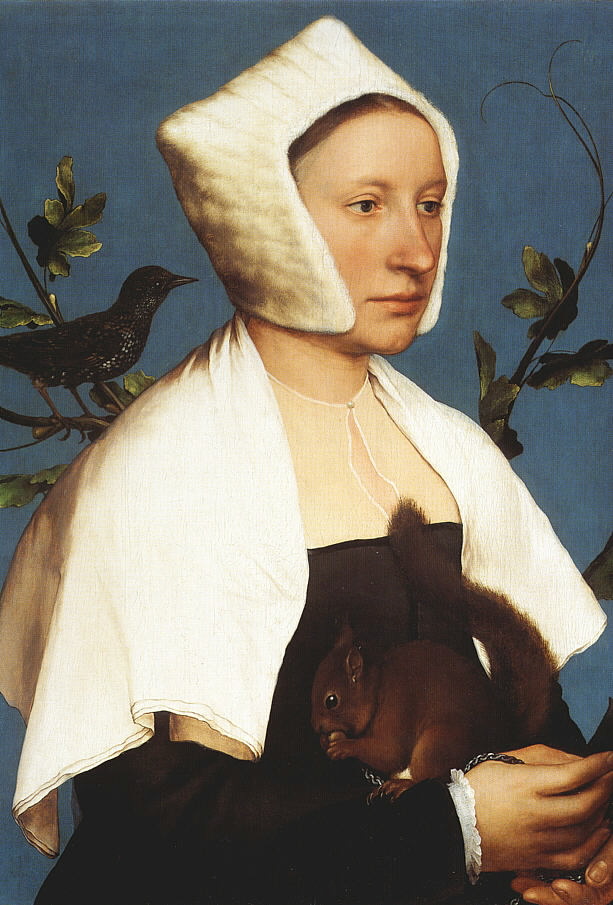 |
Directed by Shekhar Kapur. Starring Cate Blanchett and Geoffrey Rush.
|
Elizabeth is a biographical drama depicting the early years of Queen Elizabeth I and her rise to power. In the beginning, Elizabeth is portrayed as a young, naive character with flowing red hair, a soft, simple face and an air of timeless, classical features. As the film progresses the audience witness her features and aura harden as the pressures of being the Queen of England rise.
During the first few scenes, Elizabeth is seen to be young, fresh-faced and carefree. Her make-up is exceptionally simple and consists only of soft, dewy pale skin, the tiniest hint of blush and very little else. Today, this make-up appears regularly on catwalks for Spring/Summer collections, with the purpose of mimicking sporty or wet-look skin. Elizabeth's hair is also worn loosely- a popular look amongst young girls during the Tudor era.
 |
| A young and simple looking Elizabeth, plain-faced with most of her hair left down. |
Not only are Elizabeth's hair and make-up seen to change as the film progresses, but so is the way in which she dresses- naturally as she becomes Queen her outfits, jewellery and accessories grow more elaborate. At the beginning of the film, Elizabeth is adorned in simple- yet clearly aristocratic items of clothing, and is often seen wearing a pair of simple pearl earrings, and complimentary neck jewellery. Her hair is generally adorned with classic jewelled pieces. This all serves to emphasise that she is a wealthy young woman from an important background, as someone of a lower class would wear something far more simple; as exemplified in the image below:
 |
| 'Lady with a Squirrel', by Holbein. An example of what someone of a lesser background may have worn during the Tudor era- just before Queen Elizabeth's reign. The caul was also a common choice of headgear amongst the poor. |
Furthermore, As the film progresses, Elizabeth adopts even more rich and elaborate attire; her hair begins to frizz at the top of her head, and her dresses become larger and more intricate. She starts wearing more jewellery than ever before, highlighting the fact that she is Queen, and the richest woman in England.
 |
| The Queen during her first year or so of reign. |
However, as her reign progresses we notice that Elizabeth does in fact start to wear more make-up. Although a natural English Rose, her skin does start to pale more and the rouge on her cheeks and lips intensifies- albeit only slightly. Common sense somewhat dictates that Elizabeth started to wear more make-up as she grew older due to the stresses of ruling a country becoming apparent on her face. Stress often causes our cheeks to sink and our faces to hollow- hence the increasing amount of rouge (or blush). Elizabeth also starts to wear her hair up more so than in the beginning; again most probably due to stress- unfortunately stress has the tendency to show up physically on our bodies. It is likely that her hair started to grow lank and did not look as thick and healthy when worn loosely as it did when she was merely a young Princess.
The extremities build until we reach the end of the film in which Elizabeth is seen how she is remembered historically:
 |
| Elizabeth's final aesthetic |
The white, matte face, rouged cheeks and lips, and high rounded brows are all what has come to be known as the 'classic Elizabethan look'. Women would use concoctions mixed with lead to achieve their ghostly pale complexions. Rouges were made of anything ranging from crushed berries to rat's blood. Many historians actually argue that this was more than just a mere fashion trend for Elizabeth, as she is said to have experienced a case of smallpox during her younger years and wished to hide the scarring. However, the common people looked to the aristocrats for fashion inspiration so naturally, this white face make-up became a trend.
With regards to the scene in which Elizabeth shaved off all her hair in order to be reborn as a virgin; historically, there is no evidence for this. Many argue that this was simply the trend because wigs make it easy to frequently change hairstyles. Therefore this is arguably, historically irrelevant. This scene was most probably included in the film in order to engage the audience through dramatisation.
However, it is interesting to note that comically enough:- women went to extreme lengths during the Elizabethan era to achieve Elizabeth's strawberry blonde- ginger hair, such as dying their hair with urine! Frizzing hair using irons warmed in a fire was also very popular.
It is important to note that the make-up artists and hair team did not in fact use any concoctions made of lead on Cate Blanchett, or frizz her hair with hot pokers! Health and safety laws dictate that products containing lead must NEVER be applied to the skin, nor should one progress to burn an actors' scalp. Also, it is important to note that the no make-up, make-up worn by Elizabeth at the beginning of the film was set to imply that the young Elizabeth wore little to no make-up at all, as before the Elizabethan era it was generally unheard of. Make-up only really came into its stride during the 18th Century, in which Elizabethan make-up and the pale, lead-damaged skin was taken to a completely new level!





No comments:
Post a Comment